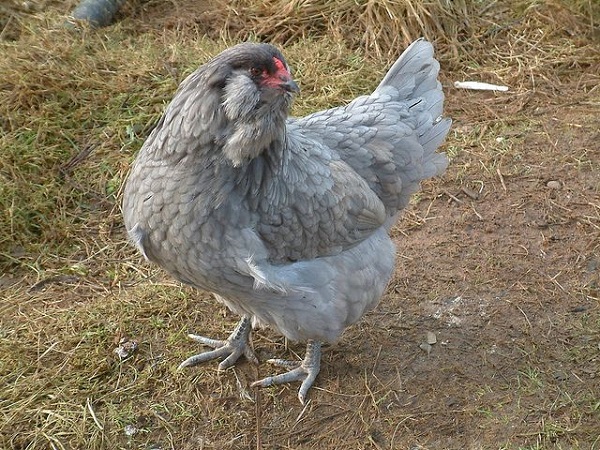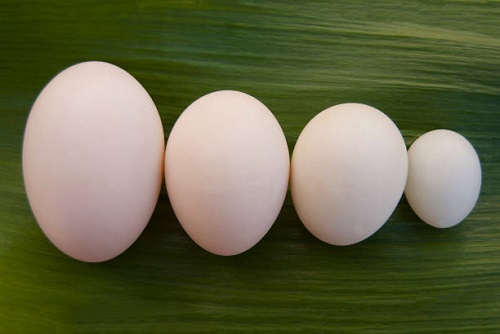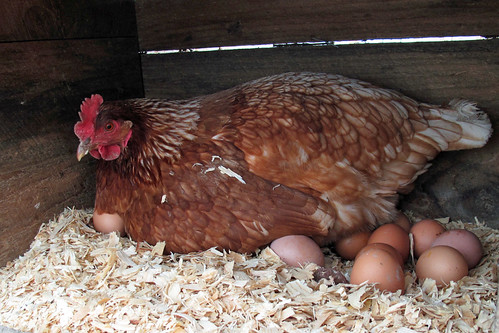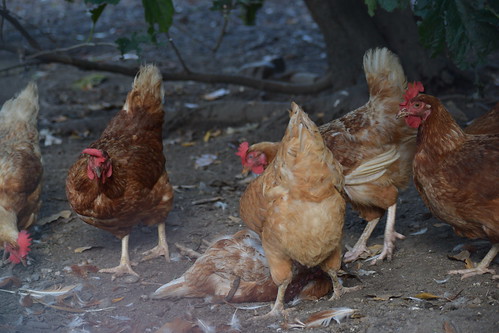The Ameraucana chicken is a newly recognized breed that lays blue eggs. (To find out where the blue eggs come from, click here). However, it should be noted though that these bearded, muffed, and tailed blue egg layers existed long before the standard was adopted by the American Poultry Association (APA) in 1984.
The APA recognizes Ameraucana chickens in eight color variants: Black, Blue, Blue Wheaten, Brown Red, Buff, Silver, Wheaten, and White. The American Bantam Association recognizes the same color variants in the Bantam size.
Ameraucana Chicken Breed Characteristics
First and foremost, Ameraucana chickens are blue egg layers. They have pea combs similar to the Araucana chicken. They are tailed, muffed, and bearded. Muffs are similar to sideburns and beards are, well beards. They also have small or absent wattles, a pea comb, and small, round earlobes, all of which are red (females pale red). Ameraucana chickens do not have tufts (earmuffs). Ameraucana chickens have slate blue-colored legs.
Ameraucana chickens come in two sizes, large fowl and bantams which are both recognized varieties. The standard cock weight is 6.5 lbs (2.9 kg), while a hen is 5.5 lbs (2.5 kg). The bantam cock weight is usually 30 ounces (0.85 kg), while the hen is 26 ounces (0.73 kg).
Color
The American Poultry Association has recognized only 8 color variants in the Ameraucana breed. They are black, pure blue, blue Wheaten, Brown red, buff, silver, wheaten and white, with black hens and blues being the best layers, while those of wheaten and blue wheaten, lay the best blue-colored eggs.
Head
The most outstanding feature of Ameraucana chickens is their small pea-shaped red crest with a dark, semi-curved beak directed downwards protruding from their sideburns and beards, which cover the ears and part of the face.
Beards in Ameraucana are rounded and fluffy, without long tufts. Its head is medium-sized. The edge of their eyes and face are palely red, making them look ferocious but, in reality, they are docile.
Body
The body of the Ameraucana is full, trimmed and horizontal, fluffy with soft feathers and half elongated, although it is still a little thin. Its neck is medium with a full layer of feathers. It has a tail that is about 45o to its body.
The chicken breed has a big chest. Its skin is white and its wings are quite prominent. The brown, reddish and silvery are the largest.
Legs
Ameraucanas have large, medium-sized thighs with soft, fluffy feathers. Their legs are slate blue and black in the black variant. They have no plumage and are strong. They have four toes with clear claws.
Eggs
Ameraucana hens lay about 250 eggs a year, an average of 5 medium-size eggs a week. The color of the shell is light blue. It starts egg production between 5 and 6 months of age but has low hatchability rates.
Lifespan
The Ameraucana chickens have a lifespan of 4 years (it has genes that allow it to face common poultry diseases) but with good care, can live up to 10 years.
Temperament
The Ameraucana chicken is a docile, quiet and friendly bird. The wheaten and blue wheaten variants are the most pleasant and easy to handle, being able to become a pet.
The white hens are the quietest. Silver, blue and black variants tend to be fleeting if they feel confined for a long time. Silvers are usually the hostile among all. But, generally, they are gentle and friendly.
Disease Resistance
The genetics of Ameraucana hens are quite resistant to typical diseases in poultry such as infectious bronchitis, avian smallpox, microplasma and coccidiosis. Of course, good care, careful attention, a balanced diet and a spacious place contribute to that.
Differences Between the Ameraucana, Americana, and Easter Eggers
There are only two breeds of chicken in the world that lay blue eggs, the Ameraucana and the Araucana breeds. These chickens are not very common. An Easter Egger is a cross between an Ameraucana or Araucana and any other chicken. A true Ameraucana chicken is NOT an Easter Egger. What is typically referred to as an Easter Egger is a hybrid chicken that possesses the gene for blue eggs, but it is not a recognized breed.
Many commercial hatcheries sell “Americana” or “Americauna” chickens. These are not Ameraucana chickens! They are just an Easter Egger. They would be a great addition to your flock, but you would not be able to show at an APA (American Poultry Association) sanctioned poultry event and these should also not be used for 4-H. Some hatcheries now have a disclaimer saying that their “Americana” chickens are not for exhibition.
There are few recognized Ameraucana breeders in the country. If you would like to buy Ameraucana chickens, use a reputable breeder.
Where Did the Blue Egg Come From?
According to a four-year University of Nottingham study published in 2013, the first blue egg appeared between 200 – 500 years ago and was caused by a virus that created a genetic mutation in the chickens. For more information on the University study, click here.
A further genetic study found the cause of the blue-colored eggshell was an ancient, harmless retrovirus in the domestic chicken. Retroviruses are a type of virus that integrates its own genetic data into the host in an unusual order. This retrovirus is responsible for inserting the gene that turns chicken eggs blue. It changes the chemistry of the eggshell so that it can take in a bile pigment from the chicken’s uterus.
“An unexpected find was the unique integration sites for the retroviruses in South American / European and Asian chickens,” said David Wragg, who led the Nottingham research project. “It shows the importance of viruses in shaping evolution and diversity of species.” David Wragg says chicken owners hundreds of years ago must have noticed that trait and incorporated it into their subsequent breeding. For more on the University of Nottingham study, click here.
Myths About Ameraucana Chickens
For many decades, some commercial hatcheries claimed that blue eggs were lower in cholesterol and higher in nutritional value and protein than other eggs. Even though this was proven to be false, many people still believe that it’s true. Blue, white and brown eggs are virtually identical nutritionally. They all supply approximately 185 milligrams of cholesterol per egg. Some people claim that blue eggs are better for baking and that they also break cleaner.
Also, the meat of an Ameraucana chicken does NOT taste like quail as some hatcheries have marketed over the years.




Please what is the quantity of feed per dual purpose starter?
I don’t understand your question
I have a roster and another chicken together the one I feel is a he’s but has never laid eggs. Is this normal? She is a yr and few months.